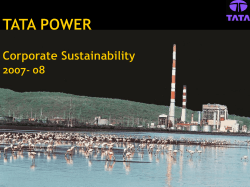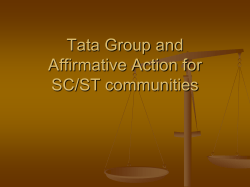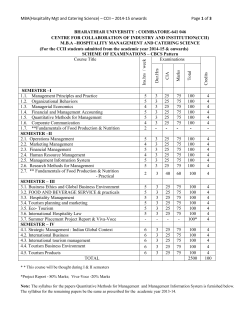
LEADERSHIP WITH TRUST……..
LEADERSHIP WITH PRESENTED BY, POONAM WAGHULDE MITALI SHIVANGI,ASHISH,PRAJAKTA NEHA,SANKET.HASAN TRUST……..ROHIT,VISHWAS AND ASHISH sawant………. TATA MOTORS….. Product Range TATA Motors: Commercial Vehicles 3 Global Footprint OTHER COLLABORATIONS/M&A & JVs • Tata Daewoo Commercial Vehicle • Hispano in Spain & Marcopolo In Brazil • JV with Jardine Matheson for ConcordeMotors • Technology Tie Ups at Spain,Italy West Europe U.K. Italy Russia* Ukraine* Central Asia Afghanistan Uzbekistan North Africa East Asia China South Korea* Egypt South Asia Bangladesh * Nepal, Sri Lanka West Africa Senegal LATAM Brazil West Asia Saudi Arabia Iraq, Iran South Africa South Africa* South East Asia Malaysia* Thailand East Africa Kenya* * Assembly Operations also 4 The Ratan RevOluTiOn….. Ratan Tata A Man Who Believes In “18 TILL I DIE” Tata Motors • • • • • • • • • Established in 1945. India’s largest automobile company. India's largest commercial vehicle manufacturer. First Indian automobile company to list on the New York Stock Exchange. It ranks among the world’s top five manufacturers of medium and heavy trucks. It is the world’s second largest medium and heavy bus manufacturer. It is India’s second largest passenger vehicle player. Has six R&D centers in India, South Korea, Spain and the UK, with over 1,400 engineers and scientists. Contd... • Starting with commercial vehicles in 1954, it entered the passenger vehicles segment in 1991. • The Tata Indica, India’s first indigenously designed car, launched in 1998. • In November 2007, the company rolled off the millionth car on the Indica platform. • The company launched the Indigo in 2002, the Indigo Marina in 2004, and the Indigo XL in 2007. • In January 2008, Tata Motors also launched the world’s least cost car, the Tata Nano(Tata Motors’ People’s Car ). • Has alliance with Fiat. Industry Overview Domestic Market Share for 2008-09 Passenger Vehicles 15.96% Commercial Vehicles 3.95% Three Wheelers 3.6% Two Wheelers 76.49% •Commercial Vehicles segment grew marginally at 4.07 %. • While Medium & Heavy Commercial Vehicles declined by 1.66%, • Light Commercial Vehicles recorded a growth of 12.29% • Commercial vehicles and Passenger Vehicles exports grew by 19.10% and 9.37% respectively. Industry Overview • Tata Motors for one, has made its position unique in the commercial segment of Indian automobile by having a presence in all spheres, light commercial vehicles, heavy commercial vehicles and the like. • However, the other leading automobile players like the Ashok Leyland and Swaraj Mazda too, are not lagging behind and they have their own aggressive expansion plans on show. • In commercial vehicle, Tata Motors dominates over 60% of the Indian commercial vehicle market. SWOT AnAlYSiS…. Strengths Weaknesses • Strong domestic player • Decline in vehicle sales • Steady revenue growth • Employee productivity • Research and development activities Opportunities Threats • Product launches • Increasing competition • Recent acquisitions • Environmental regulations PEST Analysis • Political - Operates in multiple countries - Legislation / Policy - Pressure Groups • Economical - Tata Motors functions with a global economic perspective - Global approach enables Tata Motors to adapt and learn from the many different regions and use resources COnT… • Social - Cultural Integration Vs. Separation • Technological - Focus on R&D as well as Innovation - Competition from world’s auto giants Competitive advantage • Valuable: Does the resource help a firm neutralize threats or exploit opportunities? • Rareness: Do many competitors posses it? • Costly to Imitate: Is the resource costly for a competitor to copy? • Non- Substitutable: Are there any structural/strategic equivalents? Competitive Advantage Valuable? Rare ? Costly to Imitate? NonSubstitutable ? Competitive Consequence Performance Implications No No No No Competitive Disadvantage Below average returns Yes No No Yes/no Competitive Parity Average Returns Yes Yes Yes No Temporary Competitive Advantage Average to Above average Yes Yes Yes Yes Sustainable Competitive Advantage Above average returns 16 PORTeRS 5 fORCeS….. BCG MATRiX….. Business level Strategy Develop action plan: Develop strategic measures Define strategic objectives Define the scope of measurement Value Chain Analysis Inbound Logistics • Long term contract with service provider’s – transporters and agents. • Personnel at regional offices for over seeing the smooth transit of goods. • Transparency and monitoring through deployment of IT – all transactions through SAP. • DTL supplies for critical high value items. • Efficient storage facilities – easy storage and retrieval. Operation • Capital Equipment Manufacturing division – tooling development capabilities of global standard. • Apprentice Trainee Course – ensuring stable source of skilled manpower. • Kaizen & TPM team – continuous drive to improve efficiencies. • Automated manufacturing processes. • Distributed manufacturing – Assembly units at South Africa, Thailand, Bangladesh, Brazil etc. Outbound Logistics • Stockyards, all across the country. • Long term contracts with transporter’s – higher volume of business to transporters ensures competitive price. • Regional Sales Office and Vehicle Dispatch Section linked through SAP. • Efficient security system for prevention of any kind of pilferage. Marketing & Sales Structured approach to understanding the requirements of individual customers – QFD’s conducted at regular intervals. Clear identification of product requirements, leading to development of innovative products – Tata 207 DI, Tata Ace Pan India presence and global footprint. Independent teams for addressing the requirements of institutional customers – Defense, State Transport Units Helping to augment the scarce resources – Fiat selling vehicles through Tata dealerships, in return Tata has access to Fiat’s technology and unutilized capacity. Quick assessment of the changing market dynamics and consumer preferences – Tata 407 LCV Large network of dealers – use of technology : DMS. 24 Service • Easy availability of spare parts. • Efficient collection of data from field and communication to the respective plants. • Pan India presence, as well as global presence. • Large network of workshops – Dealer workshops and TASS. • Training facilities – for dealer end and TASS personnel. Infrastructure • • • • • Multi – Location facilities Strong leadership – under the aegis of Tata Sons Best in class prototype building facilities Technology – SAP Large product portfolio HUMAN RESOURCE • Vast pool of technically competent engineers and managers. • Focus on development of technical capabilities – Technical Training Center’s, Alliance with technical Institutes • Focus on development of managerial capabilities – MTC’s , TMTC, executive training programs at premier business schools • Career advancement schemes – ESS, FTSS Technology • Approximately 2% of the annual profits of the company invested in research and development. • Knowledge portal – helps employees keep abreast with the latest technologies. • Extensive prototype building and testing facilities. • Strategic partnerships – MDI (France), Fiat etc. • Formal benchmarking process. • “ Technology Day” organized across all plant locations. Procurement • E procurement initiative. • Global Sourcing Team – China , a key destination for sourcing essential items like tires, power steering units etc., Steel procured from Belarus • Long term relationships with a stable and loyal pool of suppliers. • Technology driven procurement – SAP and VCM. • Strategic subsidiaries & JV’s – TACO group of companies , Tata Cummins • Centralized Strategic Sourcing for key components – FIP’s, Steel etc. • Group resources – Tata Steel and Tata International . • Localized supplier base at mfg. locations – low inventory levels. Diversification 1977– First CV from Pune plant. 1983– First HCV rolled out. 1986– First LCV (Tata 407) launched followed by Tata 608. 1991– First passenger car Tata Sierra launched. 1992– Tata Estate launched. 1994– Launch of Tata Sumo. 30 DiveRSifiCATiOn COnT… 1995– Mercedes Benz car E220 launched 1997– Tata Sierra Turbo launched. 1998– India’s first SUV launched. 1998– India’s first indigenous Passenger Car Indica launched. 2001– Second Generation Indica v2 launched. 2008– Launch of Suma Grande 2008– Launch of Nano at ninth Auto Expo 31 Blue Ocean STRATeGY…. Red Ocean Blue Ocean Compete in the existing market place Create unconsolidated market space Beat the competition Make the competition irrelevant Exploit existing demand Create and capture new demand Make the value cost trade off Break the value-cost trade off Differentiation or Low cost Differentiation and Low Cost 32 MERGERS AND AQUISITIONS • In 2004, TATA Motors acquired the Daewoo Commercial Vehicle Company of South Korea • TATA motors acquired jaguar and landrovers (UK based) with a value of $ 2.3 billion in March 2008. M & A CONT.... • IN 2005 TATA Motors acquired 21% stake in Hispano Carrocera SA, Aragonese bus manufacturing company with an option to acquire 100% holding Corporate Advantages from Diversified Business Sharing of Activities/Resource Tata Steel Tata Motor TCS Tata Cummins Sharing of Skills/Core Competence Tata Steel Tata Cummins Core Competence TAML TACO 35 RECOMMENDATIONS • Industry analysts expect GM to sell the Hummer brand in 2009 and without a seller in sight, there is a real possibility that the brand will cease to exist. A push in developing cutting-edge products in the Land Rover brand could enable Tata to capture Hummer customers as they look for comparable - or better products. Company needs to focus on these 3 aspects to attract the consumers of the high-end market products: • 1. Brand Appeal and Endorsement • 2. Performance Characteristics • 3. Quality Thank YOu….
© Copyright 2025











